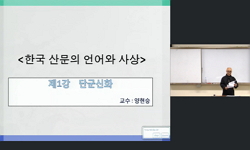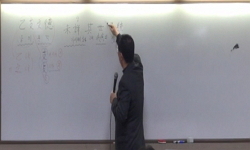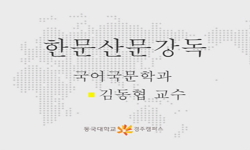우리나라의 사찰들은 일반적으로 사역의 입구인 일주문으로부터 주공간인 대웅전에 이르기까지 긴 진입과정 공간을 가지고 있다. 주공간에서는 정형적인 외부마당 구성이 이루어지는 반면...
http://chineseinput.net/에서 pinyin(병음)방식으로 중국어를 변환할 수 있습니다.
변환된 중국어를 복사하여 사용하시면 됩니다.
- 中文 을 입력하시려면 zhongwen을 입력하시고 space를누르시면됩니다.
- 北京 을 입력하시려면 beijing을 입력하시고 space를 누르시면 됩니다.
山門을 中心으로 한 傳統寺刹 進入空間의 特性 考察 = (A) Study on the Characteristics of Processional Space in Traditional Buddhist Temple, focused on the Gates
한글로보기부가정보
국문 초록 (Abstract)
본 연구에서는 한국전통 사찰건축의 진입공간의 구성요소와 그 특징들을 알아보고 특히 一柱門, 天王門, 金剛門 등의 산문을 중심으로 그 의미와 역할을 공간의 구성 속에서 파악하는데 목적이 있다.
이를 위해서 한국전통건축 공간구성의 특징과 사찰건축에 있어서의 공간개념을 파악한 후 사찰 진입부에 대한 요소와 그에 따른 의미를 찾아내고 사례를 통해 그 내용을 적용하여 분석하였다. 각 장의 내용은 다음과 같다.
2장에서는 우리나라 전통건축 공간의 특징과 질서요소를 알아보고, 사찰건축의 공간적인 구분을 하는 기준을 종교적·사상적, 시각적, 성격상으로 구별하여 각 영역별로 특징을 파악하였다.
3장에서는 사찰에 있어서의 진입공간의 정의와 그 특색을 알아보고, 진입공간을 구성하는 여러 가지 요소와 그들이 가지고 있는 공간상의 의미를 찾는다. 그리고 사찰건축의 일주문, 금강문, 천왕문, 해탈문, 불이문 등 산문의 의미와 각문의 성격과 의미를 파악하여 그에 따른 공간의 변화를 기능적인 측면, 상징적인 측면, 시각적인 측면으로 구분하여 고찰하였다.
4장에서는 2장, 3장에서 고찰한 내용을 현존하는 사찰에 적용하여 분석하였고 5장은 지금까지 살펴본 사항들을 정리하여 결론을 맺었다.
본 연구의 결론을 요약하면 다음과 같다.
사찰의 進入空間은 자연적 요소와 인공적 요소의 복합으로 主空間에 이르기 전 심리적이고 육체적인 淨化를 이루게 한다. 이러한 효과는 山門을 통해서 극대화되고 있으며, 산문은 기능적, 상징적, 시각적 측면에서 효과를 거두고 있다. 또한 각 山門은 다음 공간으로의 목표- 예비, 암시, 기대, 유인-로써 존재한다.
시각적 측면에서 여러 개의 山門이 배치되어 있어 주공간으로 들어가는 과정적 공간에 결절점을 형성하고 있으며 이 결절점은 자연 속에서 시선의 초점을 만들어 진로의 목표가 되게 한다. 山門의 좌우나 상부에 다음 건물의 모습이 중첩되어 나타나며 이는 통로가 끝나는 것이 아니고 다음 단계의 과정이 있음을 암시한다. 특히, 그림틀 효과는 암시, 기대, 동선의 유인으로 작용한다. 산문을 통과하는 동안 상승되는 연속적인 위계를 시선의 방향을 통하여 느낀다. 이는 사찰의 공간구성이 평면적이 아닌 입체적인 구성으로 되어있음을 알 수 있다.
각 단계별 특징으로 제1단계에서는 사찰 영역을 상징하는 표식들이 있는 준비단계로 주로 심리적인 면이 두드러진 공간이며 제2단계, 제3단계는 수목이나 담장 기타 구성요소들로 인하여 통로로서의 성격이 강하게 나타나고 천왕문, 금강문 등으로 상징적인 효과를 거두고 있음을 알 수 있다. 제4단계에서는 공간의 극적인 변화로 경건함을 고조시키고 있다.
평지사찰이나 구릉형사찰은 초입에서부터 주공간까지가 긴 통로로 형성이 되어 다음 목표물인 제2, 제3문 또는 중루 등이 시야에 들어오지 않거나 반쯤 가려져 있는 경우가 많다. 이는 많은 수목들 사이에서 다음 목표를 암시하여 동선이 흩어지지 않게 하고 있다. 반면, 산지사찰에서는 상대적으로 협소하고 경사가 급한 대지에 자리한 관계로 다음 목표물을 거의 완전히 보여주는 대신 단차를 많이 두고 있다. 이는 다른 사찰의 긴 통로의 역할을 산지사찰에서는 높고 많은 계단이 대신해 주고 있는 것으로 해석된다. 목표물이 제시되는 방향 역시 산지사찰의 경우가 쉽고 명확하게 직선적이며 다른 사찰에서는 약간씩 중심축에서 빗겨가고 있음을 알 수 있다. 다시 말하면 평지나 구릉형에서는 길고 수평적 진입이라면 산지사찰에서는 짧고 수직적인 것이라고 말할 수 있다.
우리나라의 사찰들은 일반적으로 사역의 입구인 일주문으로부터 주공간인 대웅전에 이르기까지 긴 진입과정 공간을 가지고 있다. 주공간에서는 정형적인 외부마당 구성이 이루어지는 반면 진입공간에서는 여러 가지 자연적, 인공적 요소를 이용하여 불교의 세계로 들어가는 과정을 상징적인 의미로 해석해 내고 있다.
본 연구에서는 한국전통 사찰건축의 진입공간의 구성요소와 그 특징들을 알아보고 특히 一柱門, 天王門, 金剛門 등의 산문을 중심으로 그 의미와 역할을 공간의 구성 속에서 파악하는데 목적이 있다.
이를 위해서 한국전통건축 공간구성의 특징과 사찰건축에 있어서의 공간개념을 파악한 후 사찰 진입부에 대한 요소와 그에 따른 의미를 찾아내고 사례를 통해 그 내용을 적용하여 분석하였다. 각 장의 내용은 다음과 같다.
2장에서는 우리나라 전통건축 공간의 특징과 질서요소를 알아보고, 사찰건축의 공간적인 구분을 하는 기준을 종교적·사상적, 시각적, 성격상으로 구별하여 각 영역별로 특징을 파악하였다.
3장에서는 사찰에 있어서의 진입공간의 정의와 그 특색을 알아보고, 진입공간을 구성하는 여러 가지 요소와 그들이 가지고 있는 공간상의 의미를 찾는다. 그리고 사찰건축의 일주문, 금강문, 천왕문, 해탈문, 불이문 등 산문의 의미와 각문의 성격과 의미를 파악하여 그에 따른 공간의 변화를 기능적인 측면, 상징적인 측면, 시각적인 측면으로 구분하여 고찰하였다.
4장에서는 2장, 3장에서 고찰한 내용을 현존하는 사찰에 적용하여 분석하였고 5장은 지금까지 살펴본 사항들을 정리하여 결론을 맺었다.
본 연구의 결론을 요약하면 다음과 같다.
사찰의 進入空間은 자연적 요소와 인공적 요소의 복합으로 主空間에 이르기 전 심리적이고 육체적인 淨化를 이루게 한다. 이러한 효과는 山門을 통해서 극대화되고 있으며, 산문은 기능적, 상징적, 시각적 측면에서 효과를 거두고 있다. 또한 각 山門은 다음 공간으로의 목표- 예비, 암시, 기대, 유인-로써 존재한다.
시각적 측면에서 여러 개의 山門이 배치되어 있어 주공간으로 들어가는 과정적 공간에 결절점을 형성하고 있으며 이 결절점은 자연 속에서 시선의 초점을 만들어 진로의 목표가 되게 한다. 山門의 좌우나 상부에 다음 건물의 모습이 중첩되어 나타나며 이는 통로가 끝나는 것이 아니고 다음 단계의 과정이 있음을 암시한다. 특히, 그림틀 효과는 암시, 기대, 동선의 유인으로 작용한다. 산문을 통과하는 동안 상승되는 연속적인 위계를 시선의 방향을 통하여 느낀다. 이는 사찰의 공간구성이 평면적이 아닌 입체적인 구성으로 되어있음을 알 수 있다.
각 단계별 특징으로 제1단계에서는 사찰 영역을 상징하는 표식들이 있는 준비단계로 주로 심리적인 면이 두드러진 공간이며 제2단계, 제3단계는 수목이나 담장 기타 구성요소들로 인하여 통로로서의 성격이 강하게 나타나고 천왕문, 금강문 등으로 상징적인 효과를 거두고 있음을 알 수 있다. 제4단계에서는 공간의 극적인 변화로 경건함을 고조시키고 있다.
평지사찰이나 구릉형사찰은 초입에서부터 주공간까지가 긴 통로로 형성이 되어 다음 목표물인 제2, 제3문 또는 중루 등이 시야에 들어오지 않거나 반쯤 가려져 있는 경우가 많다. 이는 많은 수목들 사이에서 다음 목표를 암시하여 동선이 흩어지지 않게 하고 있다. 반면, 산지사찰에서는 상대적으로 협소하고 경사가 급한 대지에 자리한 관계로 다음 목표물을 거의 완전히 보여주는 대신 단차를 많이 두고 있다. 이는 다른 사찰의 긴 통로의 역할을 산지사찰에서는 높고 많은 계단이 대신해 주고 있는 것으로 해석된다. 목표물이 제시되는 방향 역시 산지사찰의 경우가 쉽고 명확하게 직선적이며 다른 사찰에서는 약간씩 중심축에서 빗겨가고 있음을 알 수 있다. 다시 말하면 평지나 구릉형에서는 길고 수평적 진입이라면 산지사찰에서는 짧고 수직적인 것이라고 말할 수 있다.
다국어 초록 (Multilingual Abstract)
For this study, I caught the point of the characteristics of spatial organization on Korean traditional architecture and the elements and meaning of its processional space. And then I applied them in some cases and analyzed them into some facts.
The brief conclusion of this study as follows :
In functional aspect, The Gates of the processional space takes first role of coming in and out and passing, and they take second role of presentation of remarkable destination and direction to the main area. Besides, they exist as a stage of psychological purification and education by passing ceremony in solemn surroundings.
In symbolic aspect, Temples were defined by Gates as a particular spatial area against out world. These processional space express architecturally that the progress from common world to Nirvana is applied in the Buddhist dogma. That is, they are reappeared through IlJuMun that means both Nirvana and all truths are one and to go the Buddha's world, CheonWangMun that means people defeat the devil in their hearts, and HaeTalMun(解脫門) that means to escape from a anguish of transmigration of souls, and entering the world of Nirvana.
In visual aspect, the Buddhist Temple's processional space has some Gates that make knots in processing space into main area. These knots make the focus of sight in nature and are the ways ahead the destination. the right and left of the Gates and the upper part of it appear to be piled up next building. That means it is not the end but the progress to another stage. Especially, the sight of the opposite side through the inside of the Gates acts on the effect of suggestion, expectation and seduction. During passing the Gates, people notice the third dimension space effect, felt rising successful grade of rank through direction of vision. This means Temple's space construction is not plane but solid
In case of an axis of processional space, in Tongdo-Temple, it is soft bending round along the vally and is effect ed by GeumGangGyueDan in whole construction. In HwaUm-Temple, it is bending shape winded several times on the left and GakHwangJuen and stone pagoda operate the construction of axis. BumA-Temple is a straight construction connecting a steep slant with stairs. Like this, the axis of processional space is effected the topography and arrangement of whole Buddhist Temple.
Generally, Korean Buddhist Temple has a long processional space where is located from IlJuMun(一柱門), which is the entrance of a Temple's space, to DaeUngJeon(大雄殿), which is the main are of a temple. In main part, typical outer space has bee...
Generally, Korean Buddhist Temple has a long processional space where is located from IlJuMun(一柱門), which is the entrance of a Temple's space, to DaeUngJeon(大雄殿), which is the main are of a temple. In main part, typical outer space has been organized, but, in the processional space, we could feel the entering into the Buddhist mental world just as symbolic meaning, by using some natural and artificial elements. In this study, I purpose to know the elements and the characteristics in Korean traditional Buddhist Temple architecture, and particularly the meaning and role on spatial organization by mainly about Gates like IlJuMun, CheonWangMun(天王門), GeumGangMun(金剛門).
For this study, I caught the point of the characteristics of spatial organization on Korean traditional architecture and the elements and meaning of its processional space. And then I applied them in some cases and analyzed them into some facts.
The brief conclusion of this study as follows :
In functional aspect, The Gates of the processional space takes first role of coming in and out and passing, and they take second role of presentation of remarkable destination and direction to the main area. Besides, they exist as a stage of psychological purification and education by passing ceremony in solemn surroundings.
In symbolic aspect, Temples were defined by Gates as a particular spatial area against out world. These processional space express architecturally that the progress from common world to Nirvana is applied in the Buddhist dogma. That is, they are reappeared through IlJuMun that means both Nirvana and all truths are one and to go the Buddha's world, CheonWangMun that means people defeat the devil in their hearts, and HaeTalMun(解脫門) that means to escape from a anguish of transmigration of souls, and entering the world of Nirvana.
In visual aspect, the Buddhist Temple's processional space has some Gates that make knots in processing space into main area. These knots make the focus of sight in nature and are the ways ahead the destination. the right and left of the Gates and the upper part of it appear to be piled up next building. That means it is not the end but the progress to another stage. Especially, the sight of the opposite side through the inside of the Gates acts on the effect of suggestion, expectation and seduction. During passing the Gates, people notice the third dimension space effect, felt rising successful grade of rank through direction of vision. This means Temple's space construction is not plane but solid
In case of an axis of processional space, in Tongdo-Temple, it is soft bending round along the vally and is effect ed by GeumGangGyueDan in whole construction. In HwaUm-Temple, it is bending shape winded several times on the left and GakHwangJuen and stone pagoda operate the construction of axis. BumA-Temple is a straight construction connecting a steep slant with stairs. Like this, the axis of processional space is effected the topography and arrangement of whole Buddhist Temple.
목차 (Table of Contents)
- <目次> = i
- (國文抄錄) = ii
- 1. 序論 = 1
- 1) 연구의 배경 및 목적 = 1
- 2) 연구의 방법 및 범위 = 2
- <目次> = i
- (國文抄錄) = ii
- 1. 序論 = 1
- 1) 연구의 배경 및 목적 = 1
- 2) 연구의 방법 및 범위 = 2
- 2. 傳統建築 空間에 관한 考察 = 5
- 1) 전통건축 공간의 특징 = 5
- 2) 전통건축 공간의 질서 = 6
- 3) 사찰건축의 공간구분 = 9
- 3. 寺刹의 進入空間과 山門 = 10
- 1) 진입공간의 정의 및 특징 = 10
- (1) 진입공간의 정의 = 10
- (2) 진입공간의 특징 = 11
- 2) 진입공간의 구성요소 = 13
- (1) 장승 = 13
- (2) 부도 = 13
- (3) 물과 다리 = 14
- (4) 당간지주 = 16
- (5) 계단 = 17
- (6) 문 = 18
- (7) 누 = 20
- (8) 기타 석조물 = 22
- 3) 사찰건축에서 문의 의미 = 24
- (1) 고대사찰의 문 = 24
- (2) 산지사찰의 문 = 24
- (3) 사찰건축에서 문의 의미 = 25
- (4) 사찰건축 진입공간의 영역성 = 29
- 4) 사찰건축에서 문을 통한 공간의 변화 = 31
- (1) 기능적인 측면 = 31
- (2) 상징적인 측면 = 32
- (3) 시각적인 측면 = 33
- 4. 事例를 통한 適用·分析 = 35
- 1) 通度寺 = 35
- (1) 통도사의 연혁 = 35
- (2) 통도사의 공간배치 = 35
- (3) 통도사의 진입공간 = 37
- 2) 法住寺 = 41
- (1) 법주사의 연혁 = 41
- (2) 법주사의 공간구성 = 42
- (3) 법주사의 진입공간 = 43
- 3) 華嚴寺 = 47
- (1) 화엄사의 연혁 = 47
- (2) 화엄사의 공간구성 = 48
- (3) 화엄사의 진입공간 = 50
- 4) 浮石寺 = 54
- (1) 부석사의 연혁 = 54
- (2) 부석사의 공간구성 = 54
- (3) 부석사의 진입공간 = 56
- 5) 梵魚寺 = 60
- (1) 범어사의 연혁 = 60
- (2) 범어사의 공간구성 = 60
- (3) 범어사의 진입공간 = 62
- 6) 雙磎寺 = 66
- (1) 쌍계사의 연혁 = 66
- (2) 쌍계사의 공간구성 = 66
- (3) 쌍계사의 진입공간 = 67
- 7) 사례 종합 분석 = 72
- (1) 제1단계 - 사찰의 초입에서 일주문까지 = 72
- (2) 제2단계 - 일주문에서 제2문까지 = 72
- (3) 제3단계 - 제2문에서 제3문까지 = 73
- (4) 제4단계 - 제3문에서 중문(중루)까지 = 73
- (5) 대상 사찰의 각 단계별 구성요소 = 75
- 5. 結論 = 78
- References = 80
- Abstract = 83












